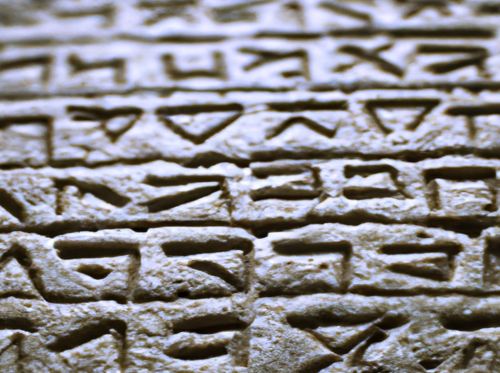Three Innovative uses of Artificial Intelligence for Languages: Understanding, Preserving and Learning
13 February, 2023

Artificial Intelligence (AI) and languages have been deeply interconnected since the former’s inception. AI’s objective is to simulate human intelligence, and language is considered one of its main expressions – if not the most important of all. Natural Language Processing (NLP) is a significant branch of Artificial Intelligence. It overlaps with Computational Linguistics, which is an area focused on modelling the basic linguistic processes, namely language production, comprehension and acquisition. As a result, essential Artificial Intelligence problems such as perception, communication, knowledge, planning, reasoning and learning are of utmost importance for this field.
Even though the applied sides of linguistics and Artificial Intelligence are more concerned with obtaining information, like in text mining or machine translation, Artificial Intelligence can also be used to help linguists solve other current dilemmas, such as saving endangered languages, reconstructing extinct ones, or improving language learning in the classroom or through apps such as Duolingo. Let’s look at three of the newest applications of Artificial Intelligence in languages: understanding dead languages, preserving endangered languages and learning new languages.
1). Understanding Dead Languages
One of the most formidable challenges linguists have to overcome is the reconstruction of languages whose original speakers and cultures have long disappeared from the face of the earth.
Unlike Ancient Greek or Latin, which have a plethora of written records and demonstrable descended languages, others remain undeciphered: their grammar, vocabulary and syntax are all but a mystery to us. Usually, these linguistic enigmas lack a related modern language, their preserved records are not enough, or the ones that have withstood the test of time are barely legible or don’t have proper punctuation to help us understand them better.
However, there has been a major breakthrough in this area of linguistics, thanks to researchers at MIT who have come up with a new Artificial Intelligence algorithm based on a neural network (described in detail in this paper), which was able to decipher Linear B, an ancient script belonging to the Mycenaean Greek language, Greek’s earliest attested form.
In contrast to previous systems, which depend on parallel data from other languages, the one put forward by MIT can decode a script without additional information. The team designed this model by setting constraints that use trends observable through the evolution of languages, such as the order of characters or vocabulary development.
On the other hand, Linear A—an even older script that is hypothetically the basis of the Minoan language of Ancient Crete—remains undeciphered due to the limited data available and the fact that it has a unique amount of symbols, which are harder to decode than letters. Despite these obstacles, the efficiency rate of this algorithm (67.3%) is high enough to set up expectations for more successful future applications. In this way, Artificial Intelligence has become an indispensable tool for linguists eager to unveil the mysteries that lie underneath these yet-to-be-decoded languages.
2). Language Preservation
Currently, humanity’s enormous linguistic diversity is under threat, as 42% of the more than 7000 languages spoken worldwide are in danger of dying out along with their speakers. In fact, on average, every two weeks a language goes extinct. This unspeakable loss of a people’s culture, customs and identity impacts all of us as members of the worldwide linguistic community, but it especially affects indigenous languages, whose populations and cultural means of expression are absorbed or simply annihilated by modern societies and the unstoppable force of technology.
Despite this sombre outlook, there is an upside to the massive encroachment of technological progress in our lives. Artificial Intelligence has been used to preserve endangered languages in a variety of projects that attempt to use different tools to keep these linguistic communities alive. For instance, OBTranslate is a “deep learning, online CAT (Computer Assisted Translation) tool, neural machine translation (NMT) and Artificial Intelligence platform for languages” which aims at overcoming language barriers and enable all languages to interact with each other, with a special focus on Africa and its many endangered dialects.
Then there are chatbots and robots which are being used to keep languages alive and allow their speakers to continue using their mother tongues through technological devices. Meet Reobot, a chatbot developed by a New Zealander who was learning Maori, but realised he had few opportunities to practise. As a result, he created a bot you can have simple conversations with on Facebook, so you can keep developing your Maori language skills.
Additionally, there is Opie, a robot designed between the Ngukurr Language Centre and the University of Queensland in Australia, which is used at local schools to maximise the thirty minutes per week teachers are given to teach Aboriginal languages.
Finally, projects such as FirstVoices intend to revitalise indigenous languages in British Columbia, Canada, by preserving language data and allowing its community to access it. They have developed a variety of tools for this purpose, such as teaching programs or apps. On their website, you can have a look at an encyclopaedia of British Columbia’s native languages, examples of words, songs and stories, and even play games to learn vocabulary.
Another interesting development is a Keyboard App that enables users to type in more than 100 indigenous languages on any device. In this way, the technology that might threaten these tongues is used as a Noah’s ark to preserve them for future generations.
3). Artificial Intelligence in language learning
Learning (and teaching) a new language is hard enough, but Artificial Intelligence’s possible uses in the classroom open up a range of opportunities to refine language learning and turn it into a smoother and more tailor-made experience.
To begin with, Artificial Intelligence can provide learners with instant feedback, as they can automatically grade exams or even analyse texts to determine their level of proficiency. By providing immediate correction, students can see their mistakes more clearly and work on their weaknesses. Additionally, Artificial Intelligence can help teachers with lesson preparation, by giving an overall score and feedback on how to adjust a text to the desired level, something that Text Inspector was specifically designed for (see our blog here on how to use Text Inspector effectively).
Another advantage is that Artificial Intelligence can personalise each student’s learning path by analysing their data and customising their education. Artificial Intelligence can determine the tasks students are best at, take into account their interests and cultural background, and focus on the things they need to improve, saving teachers plenty of time and effort while providing a tailor-made course perfectly suited to each student’s needs. Even people who suffer from dyslexia or other speech-related issues can benefit from speech recognition and transcription software.
Last but not least, learning a language can become a fun experience if gamification is exploited to create engaging comprehension activities or store vocabulary in apps such as Kahoot! or Quizlet. Going even further, other apps like Duolingo, Babbel or Slang have taken the field of language learning by storm, becoming incredibly popular thanks to their interactivity and, particularly in Duolingo’s case, the wide variety of languages offered: from behemoths like Spanish or English to constructed languages like Game of Thrones’ High Valyrian or Star Trek’s Klingon, to lesser spoken languages like Hawaiian or Welsh.
Summary
All in all, even though there are many technological obstacles to overcome and features to work on, Artificial Intelligence and language are inseparable and continue to develop hand in hand.
With the advent of tools like ChatGPT, language preservation, learning and decipherment are increasingly entwined.
Going beyond getting a faithful translation on Google Translate or acing that Welsh lesson on Duolingo, AI has become an extremely useful tool that may as well hold the key for extending and preserving our knowledge of language, the greatest testament to our evolution as human beings.
Contributed by Victoria Martínez Mutri
Victoria is a CELTA-certified English as a Foreign Language teacher, with a background in Translation, from Buenos Aires, Argentina. Fascinated by language since an early age, she’s particularly interested in the fields of Applied Linguistics and Sociolinguistics. She’s been researching and writing about gender-inclusive language since 2018. After graduating, she would like to obtain a Master’s Degree in Linguistics at a foreign university.
Share
Related Posts

5 Things you should know about big data in NLP (Natural Language Processing)
15 September, 2023
In today’s digital world, data is a critical component of every aspect of our lives. From the personal data we generate as we go about our daily activities to the vast amounts of data that businesses collect, analyze, and use to drive decision-making, data has become an essential resource for individuals and organizations alike.
Read More ->
One easy boost to your writing: Using affixal negation to improve your vocabulary
27 February, 2023
Today we talk about an easy way to improve your vocabulary: affixal negation. Writing is […]
Read More ->
What Is The CEFR Level of Harry Potter? (Part 1)
12 May, 2025
The Harry Potter series is not only a global literary success but also a valuable […]
Read More ->